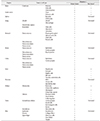1. Araki T, Milbrandt J. Ninjurin, a novel adhesion molecule, is induced by nerve injury and promotes axonal growth. Neuron. 1996; 17:353–361.
2. Araki T, Zimonjic DB, Popescu NC, Milbrandt J. Mechanism of homophilic binding mediated by ninjurin, a novel widely expressed adhesion molecule. J Biol Chem. 1997; 272:21373–21380.
3. Ahn BJ, Lee HJ, Shin MW, Choi JH, Jeong JW, Kim KW. Ninjurin1 is expressed in myeloid cells and mediates endothelium adhesion in the brains of EAE rats. Biochem Biophys Res Commun. 2009; 387:321–325.
4. Ifergan I, Kebir H, Terouz S, Alvarez JI, Lécuyer MA, Gendron S, Bourbonnière L, Dunay IR, Bouthillier A, Moumdjian R, Fontana A, Haqqani A, Klopstein A, Prinz M, López-Vales R, Birchler T, Prat A. Role of Ninjurin-1 in the migration of myeloid cells to central nervous system inflammatory lesions. Ann Neurol. 2011; 70:751–763.
5. Lee HJ, Ahn BJ, Shin MW, Choi JH, Kim KW. Ninjurin1: a potential adhesion molecule and its role in inflammation and tissue remodeling. Mol Cells. 2010; 29:223–227.
6. Lin SJ, Wideliz RB, Yue Z, Li A, Wu X, Jiang TX, Wu P, Chuong CM. Feather regeneration as a model for organogenesis. Dev Growth Differ. 2013; 55:139–148.
7. Choi S, Park C, Ahn M, Lee JH, Shin T. Immunohistochemical study of arginase 1 and 2 in various tissues of rats. Acta Histochem. 2012; 114:487–494.
8. Kubo T, Yamashita T, Yamaguchi A, Hosokawa K, Tohyama M. Analysis of genes induced in peripheral nerve after axotomy using cDNA microarrays. J Neurochem. 2002; 82:1129–1136.
9. Lee HK, Lee H, Luo L, Lee JK. Induction of Nerve Injury-Induced Protein 1 (Ninjurin 1) in myeloid cells in rat brain after transient focal cerebral ischemia. Exp Neurobiol. 2016; 25:64–74.
10. Koike M, Ninomiya Y, Koike A. Characterization of Ninjurin and TSC22 induction after X-irradiation of normal human skin cells. J Dermatol. 2008; 35:6–17.
11. Rogers JV, Choi YW, Giannunzio LF, Sabourin PJ, Bornman DM, Blosser EG, Sabourin CL. Transcriptional responses in spleens from mice exposed to Yersinia pestis CO92. Microb Pathog. 2007; 43:67–77.
12. Jennewein C, Sowa R, Faber AC, Dildey M, von Knethen A, Meybohm P, Scheller B, Dröse S, Zacharowski K. Contribution of Ninjurin1 to Toll-like receptor 4 signaling and systemic inflammation. Am J Respir Cell Mol Biol. 2015; 53:656–663.
13. Odoardi F, Sie C, Streyl K, Ulaganathan VK, Schläger C, Lodygin D, Heckelsmiller K, Nietfeld W, Ellwart J, Klinkert WE, Lottaz C, Nosov M, Brinkmann V, Spang R, Lehrach H, Vingron M, Wekerle H, Flügel-Koch C, Flügel A. T cells become licensed in the lung to enter the central nervous system. Nature. 2012; 488:675–679.
14. Yang HJ, Zhang J, Yan W, Cho SJ, Lucchesi C, Chen M, Huang EC, Scoumanne A, Zhang W, Chen X. Ninjurin 1 has two opposing functions in tumorigenesis in a p53-dependent manner. Proc Natl Acad Sci U S A. 2017; 114:11500–11505.
15. Kim JW, Moon AR, Kim JH, Yoon SY, Oh GT, Choe YK, Choe IS. Up-regulation of ninjurin expression in human hepatocellular carcinoma associated with cirrhosis and chronic viral hepatitis. Mol Cells. 2001; 11:151–157.
16. Woo JK, Jang YS, Kang JH, Hwang JI, Seong JK, Lee SJ, Jeon S, Oh GT, Lee HY, Oh SH. Ninjurin1 inhibits colitis-mediated colon cancer development and growth by suppression of macrophage infiltration through repression of FAK signaling. Oncotarget. 2016; 7:29592–29604.






 PDF
PDF ePub
ePub Citation
Citation Print
Print




 XML Download
XML Download